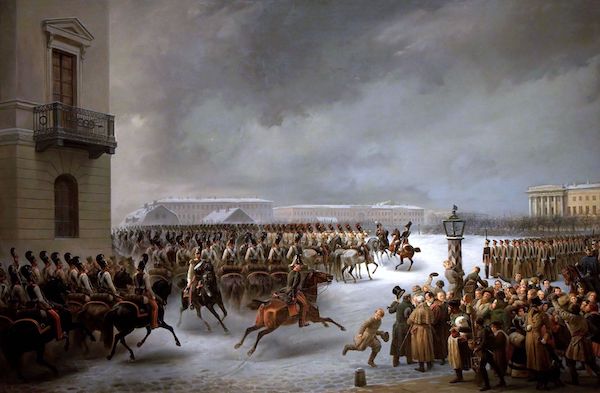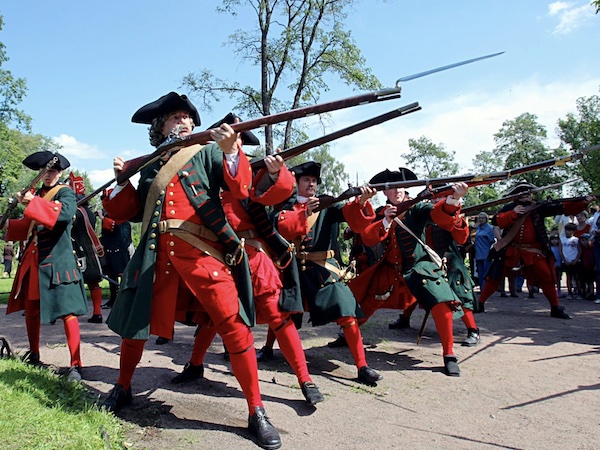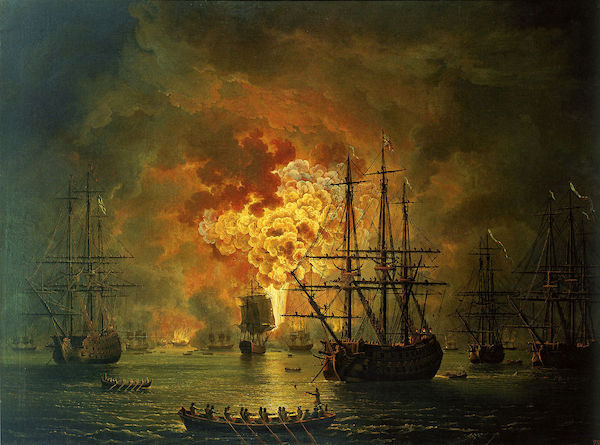Viết tiếp phần trước về Napoleon và Alexander-1… Sau thất bại thảm hại trên đất Nga, Napoleon chạy về Pháp, gom góp được khoảng 70 ngàn quân để chống lại Liên minh thứ 6 đang áp sát nước Pháp (The 6th coalition, bao gồm: Nga, Anh, Áo, Phổ, Thuỵ Điển, Tây Ban Nha… tất cả đều là những vương quốc). Với tài năng quân sự thiên bẩm của mình, Napoleon tiếp tục thu được một số thắng lợi nhỏ, Liên minh thứ 6 đã rất nản lòng muốn dừng lại. Nếu không phải vì quyết tâm của Sa-hoàng Alexander-1, minh chủ của liên minh, thì e rằng chiến dịch đã thất bại! Alexander-1 áp sát Paris, sau một số trận đánh nhỏ thì Paris đầu hàng, Napoleon thoái vị và bị lưu đày ở đảo Elba. Alexander-1 được cả châu Âu tung hô như một anh hùng, là người giải phóng, người cứu rỗi.
Nhưng kỳ lạ thay, Sa-hoàng Alexander-1 sau đó bắt đầu nói về… cộng hoà, về dân chủ và hiến pháp, thể hiện tư tưởng tự do, tân thời như vừa lấy ra từ sách của Rousseau vậy! Các nhà chính trị châu Âu cảm thấy bàng hoàng, khó hiểu (nên nhớ Liên minh thứ 6 gồm toàn các vương quốc), nhưng cũng cứ gật gật, dù sao thì Alexander-1 cũng là người chiến thắng, cứ để cho ông ta nói cho sướng miệng! Một số vị già đời hơn thì cho rằng Alexander-1 là kẻ gian manh, muốn dùng chiêu bài “cộng hoà” để đối phó với một châu Âu “bảo hoàng”! Nhưng Alexander-1 có “gian manh” hay không thật khó lòng nói cho rõ, vì ông ấy có hành động thực sự! Sau khi Napoleon thất bại, Phần Lan và Ba Lan trở thành một phần của đế chế Nga, được thiết lập chế độ “Quân chủ Lập hiến”!
Lần đầu tiên trong một đế chế, có 2 chủ thể có hiến pháp và nghị viện riêng! Alexander-1 còn cho xây dựng những mô hình “công xã”, nơi binh lính và nông dân chung sống và sản xuất! Nước Nga bản chất vẫn là quân chủ toàn trị, nhưng đã có những dự thảo bãi bỏ chế độ nông nô, thành lập Nghị viện và Hiến pháp! Đương nhiên, tất cả chỉ mới là “dự thảo”, vị hoàng đế Alexander kia có phải muốn dùng Ba Lan, Phần Lan như những mô hình thử nghiệm hay không thì không ai thực sự rõ! Nhưng một điều rất rõ: tất cả các đời Sa-hoàng, ngay từ vị đầu tiên là Peter-the-great, đều hiểu sự cần thiết của việc bãi bỏ chế độ nông nô, nô lệ, của việc xây dựng nhà nước pháp quyền! Việc bãi bỏ nông nô, biến họ trở thành người tự do, sẽ nâng cao năng suất lao động, ít nhất trên lý thuyết là như thế!
Người tự do, vì lợi ích của bản thân, sẽ tạo ra nhiều của cải vật chất hơn, khiến cho quốc gia trở nên hùng mạnh hơn! Nên để tiếp tục “tranh bá” với các nước châu Âu thì Nga buộc lòng phải bãi bỏ chế độ nông nô, nô lệ! Năm 1819, Sa-hoàng Alexander-1 thông qua Luật nông dân, thử nghiệm bãi bỏ chế độ nông nô ở vùng mà ngày nay là Estonia và Latvia! Nhưng ông ta chết khi chưa kịp nhìn rõ kết quả cải cách của mình. Người em của ông là Nicholas-1 nối ngôi thì xảy ra vụ bạo loạn Hội tháng Chạp – The Decembrists! Đây là một hội các sĩ quan, quý tộc Nga có tư tưởng tiến bộ, muốn canh tân đất nước, về bản chất, động cơ của họ là tốt. Trở lại với Chiến tranh vệ quốc 1812 trước đó, làm sao người Nga thắng được khi quân đội của họ vừa ít hơn về số lượng, vừa kém hơn về chất lượng? Vì họ đã tổ chức một hình thức “chiến tranh nhân dân” với vô số các đội du kích!
Nhưng “chiến tranh nhân dân” tàn phá nghiêm trọng đời sống nông dân! Hội “Tháng Chạp” thấy rõ điều này và muốn cải thiện đời sống cho tầng lớp nông dân, nhưng tiếc là cách làm của họ từ đầu đã không đúng! Họ tổ chức “biểu tình có vũ trang” tại St. Petersburg, Nicolas-1 cử Bá tước Miloradovich đến thương thuyết, người ta bắn chết ông ấy! Nicolas cố gắng thương thuyết cả một ngày dài không đạt kết quả gì, sau đó là một kết cục điển hình rất Nga: các đội kỵ binh được tung vào, đại bác bắn thẳng vào đoàn biểu tình, cả ngàn người chết, sau đó là bắt bớ và lưu đày, vô số người đi Siberia! Trở lại với việc thử nghiệm bãi bỏ chế độ nông nô ở vùng Baltic đã đem lại kết quả tốt và đến giữa thế kỷ 19 đã thực hiện chế độ giáo dục phổ thông 12 năm bắt buộc, một bước tiến rất lớn về xã hội!
Nhưng nên nhớ rằng, những nước Estonia, Latvia và vùng phía Tây Bắc nước Nga là không gian ảnh hưởng nặng bởi văn hoá Đức – Phổ, trình độ dân trí khá cao, cải cách xã hội đã diễn ra thuận lợi! Ở vùng Trung và Nam nước Nga, sự việc khó khăn hơn rất nhiều! Cốt yếu vẫn là một lưỡng đề mâu thuẫn: nông nô là nền tảng của chế độ phong kiến, bãi bỏ nông nô thì tầng lớp quý tộc, địa chủ mất đi miếng ăn, sẽ không còn ủng hộ, trung thành với triều đình nữa! Nên sự việc lần lữa mãi đến 1861, đến triều đại của Alexander-2 thì mới chính thức thi hành, về thời gian thì cũng chỉ sau Đức, Áo vài năm, không phải là chậm lắm! Nhưng đây cũng là bước đầu tiên dẫn tới sự diệt vong của chế độ Sa-hoàng! Về nguyên tắc, bãi bỏ nông nô chính là giải phóng sức lao động, nhưng đó chỉ là lý thuyết suông!
Trong thực tế, người nông nô Nga đã sống cả ngàn năm như thế, họ không biết làm gì với cái tự do “từ trên trời rơi xuống”! Triều đình thực hiện một chính sách bán đất trả góp cho những nông nô mới được giải phóng, nhưng chỉ sau vài năm, kết quả… đảo ngược! Mùa màng thất bát, vay nợ, cắm đất, chìm ngập trong rượu chè, bài bạc, không biết làm gì, các nông nô quay về làm việc cho các ông chủ cũ, những người, bằng vô số mánh khoé, các thủ đoạn hắc ám, tiếp tục duy trị địa vị chúa đất của mình. Từ đó hình thành một tầng lớp chủ đất mới, về pháp lý không phải là chủ, nhưng vẫn là những ông chủ trong thực tế, đó là các… kulak! Như thế, từ một động cơ tốt đã dẫn tới một xã hội còn bất ổn trầm trọng hơn trước! Tầng lớp kulak này kinh khủng đến mức họ kiểm soát 90% ruộng đất toàn Nga!
Nên sau Cách mạng tháng 10, chính quyền mới buộc lòng phải làm một cuộc thanh trừng đẫm máu, đưa các thành phần kulak này vào… gulag, cố gắng tìm cách thay đổi những cơ cấu kinh tế, xã hội lỗi thời, tìm cách thay đổi não trạng và phong tục tập quán của các làng xã xưa cũ! Ở đây thấy rõ một việc: ở vùng phía Bắc, Tây Bắc nước Nga, không gian văn hoá, dân trí cao hơn hẳn, cải cách xã hội đã diễn ra tương đối thành công! Ở những vùng còn lại, sự việc dần dần biến thành thảm hoạ, trở thành một trong những nguyên nhân khiến chế độ phong kiến Sa-hoàng diệt vong hơn 50 năm sau! Nên phải có “trí” thì mới thành “chủ” được, chứ dân “ngu” thì vô phương, chả có cách nào, dù có lý tưởng đi chăng nữa thì quyết định tương lai của người dân vẫn là tâm địa và văn hoá của chính họ!





